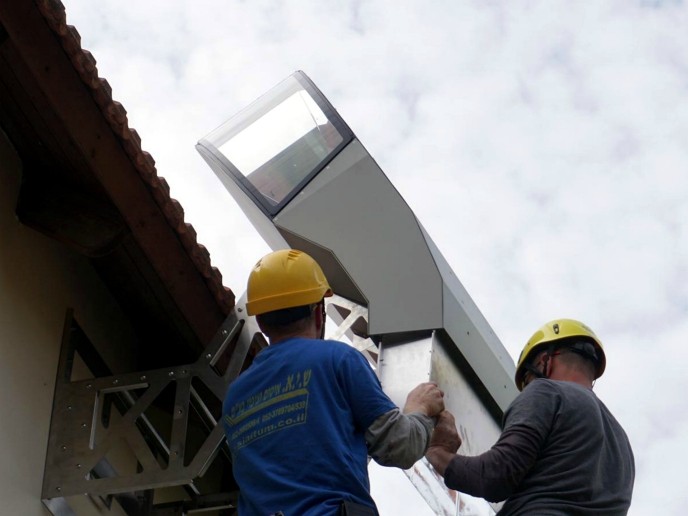Robo-Mate: from brain muscle gathering to heavy weight lifting
Despite growing automation in European industry, a lot of tasks still involve manual handling. This comes at a considerable cost – that of workers’ health. In Europe alone, 44 million workers suffer from occupational musculoskeletal disorders (MSDs). Not only does this impact their daily life and shorten their careers, but it also costs Europe as much as 3 % of its GDP. If you had to put that problem in the hands of a Hollywood blockbuster scenarist, he’d probably tell you that the answer is crystal clear: if workers are to move ever heavier objects with less effort, that requires an exoskeleton. And as science fiction-esque as it may sound, researchers from 12 European organisations would actually concur. Together, these organisations - among which the Zurich University of Applied Sciences, IIT, Fraunhofer and Ropardo - initiated the ROBO-MATE (Intelligent exoskeleton based on human-robot interaction for manipulation of heavy goods in Europe’s factories of the future) project with one objective in mind: putting together an intelligent, easy-to-manoeuvre, wearable exoskeleton for manual-handling work. ‘We had long discussions with end-users and internal brainstorming sessions that helped us come up with and dismiss different concepts,’ explains Dr Konrad Stadler, coordinator of the project for Zurich’s University of Applied Science. ‘In the end, we decided in favour of the concept that fitted best the requirements of end-users while also being achievable within three years: a modular, light-weight exoskeleton for the handling of goods up to 15 kg.’ A step ahead The most important word here is ‘modular’. Unlike any other industrial exoskeleton concept, Robo-Mate consists of four different modules that can either be combined or used as a stand-alone support technology. These include a trunk module that applies a supportive force to the worker’s hips and upper body reducing compression forces in the lower back by up to 25 %; a passive arms module providing a constant lift to the worker’s arms to handle constant loads; an active arms module providing a variable lift for pick and place tasks; and a human-machine interface (HMI) module to help workers interact with the exoskeleton or display assembly instructions. ‘There are two unique aspects of Robo-Mate: One is the construction of the passive arm module. Unlike other passive arms, it provides a constant lift no matter where your hands are and without any heavy motors and batteries. The second aspect is our modular concept: We have seen that there is no one-size-fits-all approach to the problem of heavy object handling. By providing different modules, we allow industry to select the one module or the combination of modules that is best to perform a given task,’ Dr Stadler explains. Getting there wasn’t an easy task. Other exoskeleton concepts had already been running for five or more years when the ROBO-MATE project started, and the team only had three years to beat them. ‘The other problem was and still is weight’, says Dr Stadler. ‘For the exoskeleton to be user-friendly, it has to be lightweight. But current actuation technology that meets requirements in respect of movement speed and support torque results in too heavy and too bulky systems. That was a huge challenge which we overcame with a parallelogram design for both the active and the passive arm modules.’ Turning heads in industry Judging by media and industry interest around the concept, it is safe to say that the consortium has a winning formula on its hands. The trunk module, passive and active arms have all been tested extensively at Centro Ricerche Fiat, COMPA and INDRA, and the final prototype demonstration that took place in Sibiu, Romania in August 2016 attracted representatives from over a dozen companies. In total, 70 companies have already contacted the consortium to express their interest, and three are currently negotiating with a project partner to rent modules for testing. ‘Tests conducted in our laboratories have helped us measure muscle activity and perceived exertion with and without the exoskeleton,’ says Dr Stadler. ‘Workers also tested the modules in production environments and we measured cycle times of specific tasks and perceived exertion/usability.’ Results from these tests show that the modules can indeed protect workers from injuries while improving efficiency. Moving further: from industry tests to market With the project completed at the end of November, core partners are now focusing on commercialisation of their technology. Four of the partners joined forces with an exoskeleton manufacturer and have submitted an application under the Horizon 2020 Fast Track to Innovation (FTI) scheme to bring the trunk module to market, while six companies from the automotive, construction and manufacturing sector will participate in further testing. In the meantime, two other partners are looking into a possible application for another European grant. ‘We are also planning a start-up company,’ says Dr Stadler. ‘All in all, we think that the passive arms module can be commercialised within a year, the active arms in 2-3 years and the trunk module in 3-4 years. But that depends a lot on whether we are successful with our applications for follow-up projects and this start-up company.’
Keywords
ROBO-MATE, MSD, musculoskeletal disorders, exoskeleton, module, human-machine interface, passive arms, prototype







